Growing cucumbers in a barrel
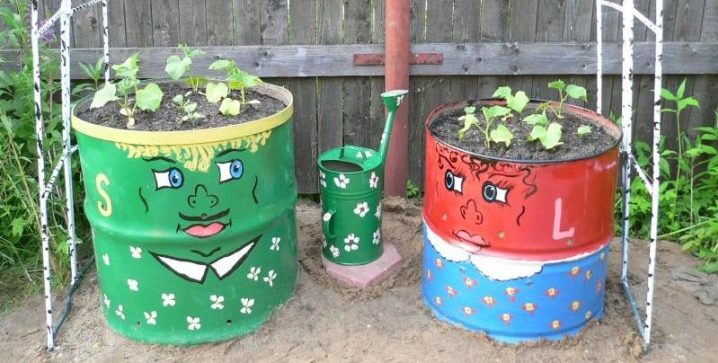
Almost all gardeners want to show off to their neighbors the originality of their site. But achieving this can be tricky if everyone else grows the same. You can change the appearance of the site by planting plants in different ways. You will love the way to grow cucumbers in barrels, not only because it will amaze your guests, but also because it saves a lot of space. These are just some of the advantages of this planting method, you can read about the rest in this article.
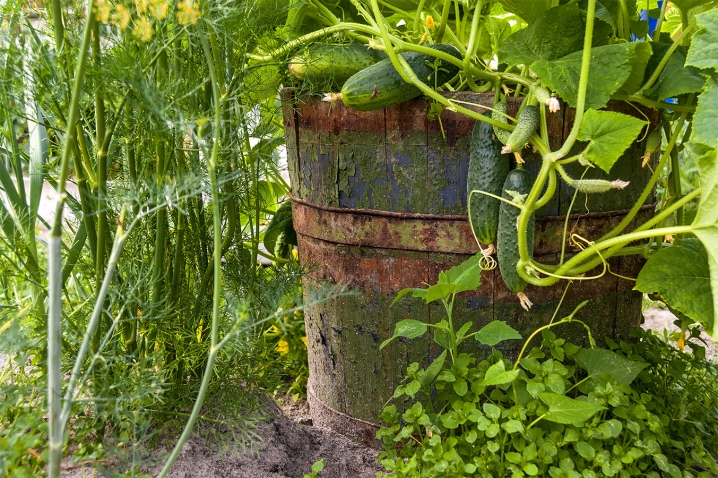
Advantages and disadvantages
This growing method has long been loved by gardeners due to the unusual appearance of familiar vegetables, ease of care and ease of harvesting. Once growers discovered the benefits of barrel planting, they began to plant other crops in the same way.
The benefits of this unique planting method are numerous:
- you can save space in your garden;
- no need to bend over to harvest;
- fruits are clearly visible and not contaminated with soil;
- watering the roots is much easier;
- the sun's rays fall evenly;
- the owners do not step on the whip of cucumbers;
- there are fewer weeds, because the planting area is not so large;
- sunlight and humus warm up the root soil, which significantly increases the quantity and quality of fruits;
- due to being at a distance from the ground, cucumbers are less susceptible to diseases;
- beautiful appearance of the fruit;
- after harvesting, the gardener teaches a whole barrel of compost.
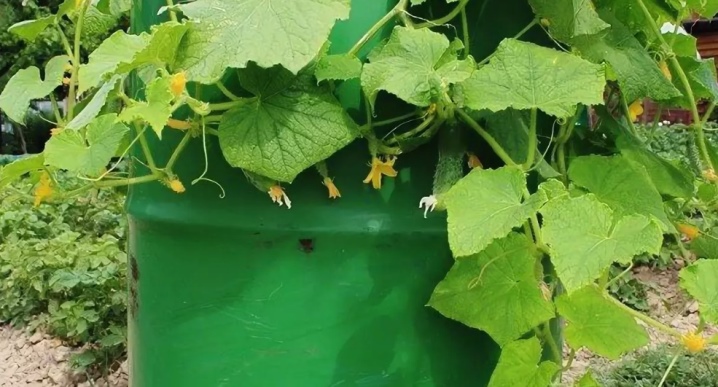
There are some minor drawbacks, but they can be easily eliminated with the right approach:
- seedlings need to be watered often because they have no other way to get moisture, for example, by absorbing groundwater;
- it is necessary to add earth during the active growth phase;
- if there is no container, then you will have to spend money on buying a barrel.

Barrel selection
Any gardener will be able to find a suitable container in their area. This can be a metal, plastic barrel, or even a wooden box. You can use for these purposes and barrels that are no longer used for their original purpose. If the container is old, rusty, with no bottom, holes or cracks, this will only be an advantage, as it will allow air to circulate and excess moisture to drain.
Holes will need to be drilled in plastic containers. The volume of barrels varies from 100 to 250 liters, 200-liter iron barrels are very common.
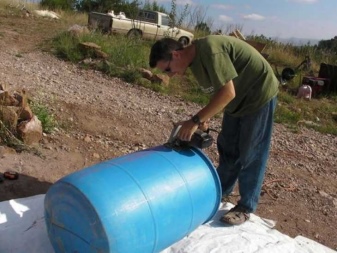
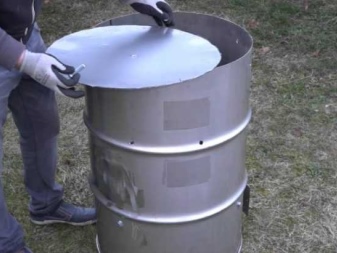
Planting process
Most of the work is done during the preparation stage for planting. The rest of the process is not much different from other methods of growing crops.
Preparation
You need to prepare for planting cucumbers in barrels from the moment the snow melts on the street.
- Choose a well-ventilated and shady place for the barrel... Next, provide unhindered access to the plant from four sides.
- Remove the bottom of the planting container or drill some large holesso that excess water does not stagnate.
- Fill the barrel about 1/3 full with twigs, stones, rags, braids, or other plant debristhat will serve as drainage.
- Fill the next third with decomposed fertilizer. This will help warm the roots of the seedlings from below. If you do not have fertilizer, you can add a small amount of cut grass, sawdust mixed with soil, tree bark, or food waste.
- The top layer is fertile soil... Leave 10 cm to the edge of the instillation barrel. This will protect the seedlings from the cold and cover the cucumbers at night for the first time.
- If the sprouts have not grown to the edge of the container, just cover them with foil or acrylic.
- In order for young shoots to grow further, they need a frame... It is made from a suitable material such as thin slats or plastic greenhouse arches. When installing the barrels along a wall, pull the threads from the ground to the barrel and also secure them to the wall. As the leaves grow, a wall of cucumbers forms (reminiscent of hops or a girl's vine) and juicy fruits appear that look very unusual.
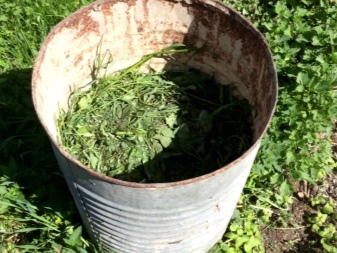

Landing
Hosts can grow seedlings or sow seeds directly into the soil. To plant seeds in a barrel, do the following:
- Water the soil in a container a day or two before planting.... This will cause some shrinkage, so make sure the soil has been restored to its original volume.
- Make small holes in the loosened soil 2 to 3 cm deep. The number of holes is calculated based on the number of seeds (maximum six per barrel), plus 2 or 3 seeds in case of poor yields or weak seedlings.
- Then cover the seeds with decomposed humus.
- In the first few days, until strong shoots appear, cucumbers should be carefully watered with warm water from a narrow container with a sprinkler.
- Next you need cover the seedlings with foil and tighten the twine around the outside of the barrel, and you have a small greenhouse.


Care
The best way to get a lot of juicy cucumbers in a relatively short period of time is by taking good care of the plant.
It must be remembered that cucumbers cannot be planted in their original place for 4 years. The soil in the barrels must be completely replaced for each next generation.
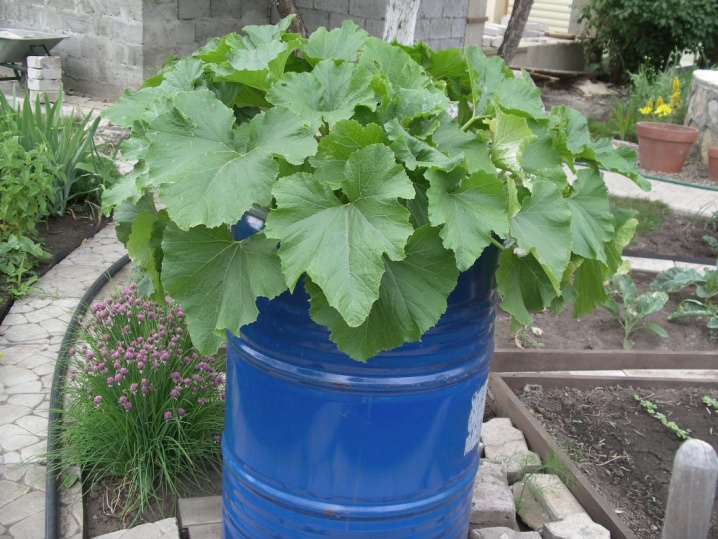
Watering
Cucumbers need enough water for vigorous growth and fruiting... If there is not enough of it, you will not have to wait for a juicy harvest. Insufficient drip irrigation can also cause the characteristic bitter taste. Beneficial minerals are transported to the roots along with water. The vertical placement of the improvised bed will facilitate water flow.
The contents of the barrels will warm up better than the usual bed, but dry quickly. The water supply should be frequent enough, three to four times a week. Pour at least 3 liters of warm water under each bush. After watering, mulch the soil with organic matter, this will keep the water inside.
There is a fun way to give your plants extra water. Cut off the bottom of the plastic bottle, close the neck with a cap and drill many small holes with a diameter of 2-3 mm around it. Place the jar, neck down, in the ground, leaving a couple of centimeters above the ground. This is best done when filling the barrel. The container must always be filled with water. It will gradually enter the ground and maintain the required moisture content.
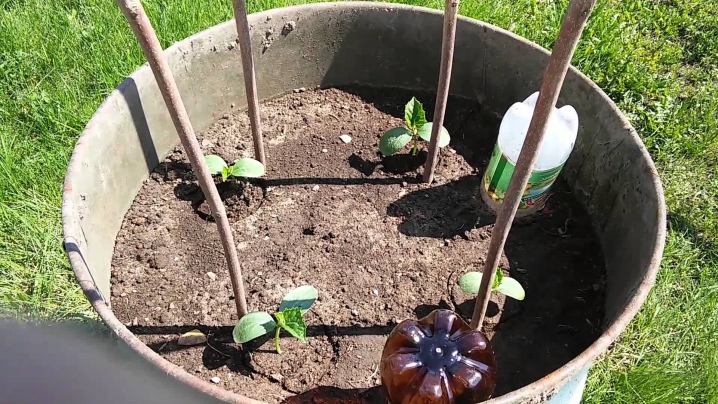
Burying a loose-bottomed plastic bottle in the ground can provide additional moisture for the roots.

Top dressing
To prepare the soil, a fertile mixture is placed in the container, since the cucumbers planted in barrels need to be fed. The feeding area of each bush is rather small, so minerals and trace elements may not be enough. In order for cucumbers to become strong and robust, they must receive nitrogen in large portions during the growth of green bushes and before flowering.
After the start of fruiting, nutrients must be applied every two weeks. It is best to alternate mineral and organic nutrients as follows:
- Dissolve 1 tablespoon of nitrophoska in 10 liters of water, using 1 liter of solution per bush. You can use two types of organic fertilizers.
- 10-14 days after applying chicken manure (1: 10) or cow dung (2: 10) dilute 1 liter of concentrated mixture with 10 liters of water to prepare a solution at the rate of 1 liter per bush.
- If chicken or cow dung is not at hand, it can be successfully replaced with the so-called green infusion.Weeds and cut grass must be infused in warm water for 10-12 days, and the fermented liquid is fed to cucumbers. Experts note that such fertilizer is not inferior to humus in terms of the amount of useful microelements.
The cut grass can just as well be used as an organic fertilizer.
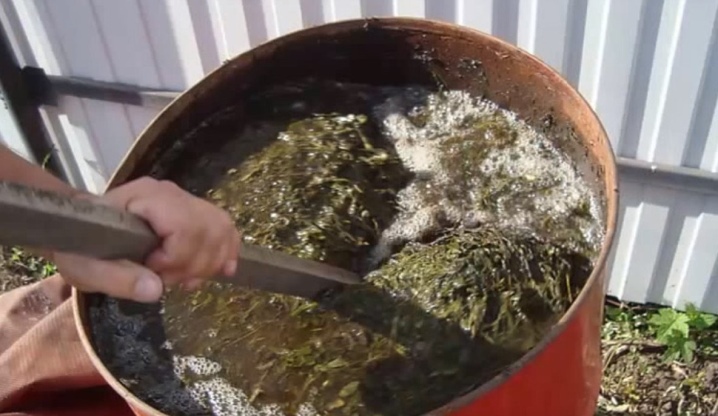
Formation
Barrel-grown cucumbers need to be shaped, which directly affects their ability to bear fruit. Based on the need for pollination of the plant, it is recommended to use two methods of formation. Let's take a closer look at the technology and subtleties.
- Self-pollinated hybrids are formed on one stem. Collect all growing branches (flowers and stems) from the axis of the first five leaves. When the next five leaves have grown, remove the stem as it emerges, leaving the flowers and ovary in the bosom. When the stems are one meter high, leave a few stems to form lateral shoots. When three or four leaves appear, cut them back to create new side shoots.
- Cucumber varieties that are pollinated by bees are often bush-shaped. It is achieved by trimming the tops when the fifth or sixth true leaf appears to stimulate vigorous stem growth. After the fifth leaf is formed on each lateral bud, the tops above it should also be removed. The ovary will be concentrated on the tenth to twelfth branch formed. Female flowers are formed mainly on lateral shoots, so one bush can be left for pollination without pruning - it will give empty flowers, which are a source of pollen.
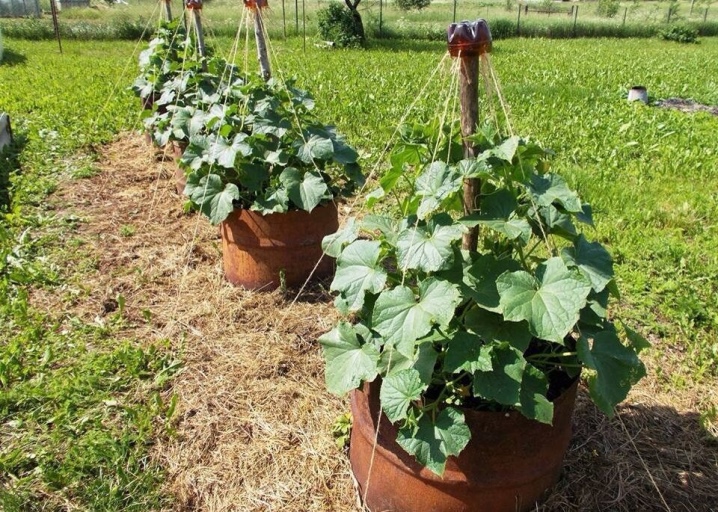
Garter
One of the easiest tie-down methods is to place a two meter long wooden or metal support with two cross bars in the center of the tank. Three or four crosses can be fastened together to form six or eight beams, respectively. A peg must be driven in along the edges of the barrel, to which the twine is tied and attached to the trellis. When five or six main leaves appear on the bushes, tie them to a twine. The branches cling to the string and grow upward, eventually twisting around the cross.
There is another popular garter method: two metal or plastic arcs are placed crosswise to form a base. When the cucumbers grow and need a garter, they will need to be tied to the arches. These supports are not very tall, so long stems hang over the rim of the barrel. To prevent the plant from getting hurt on sharp edges, an unnecessary watering hose should be attached to them.
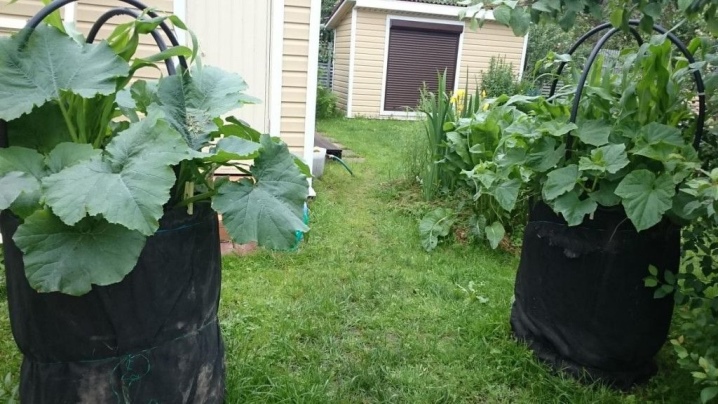
Topping
By pinching, owners can significantly increase yields. Below, the scheme will be described step by step, which is used for self-pollinated varieties (formation of 1 stem).
- Remove flowers and stems after the first five leaves appear.
- Remove only lateral shoots later.
- When the shoot grows to 1 m, leave a few stems and cut them after 3-4 leaves. This will result in a third circle of buds.
For bee-pollinated varieties, the method of forming a bush is to trim the main stem above the fifth leaf. Then a stem will appear, which is also pinched over the fifth leaf. This will promote the formation of the main maternal stem, which will stimulate the formation of about 10 more stems.
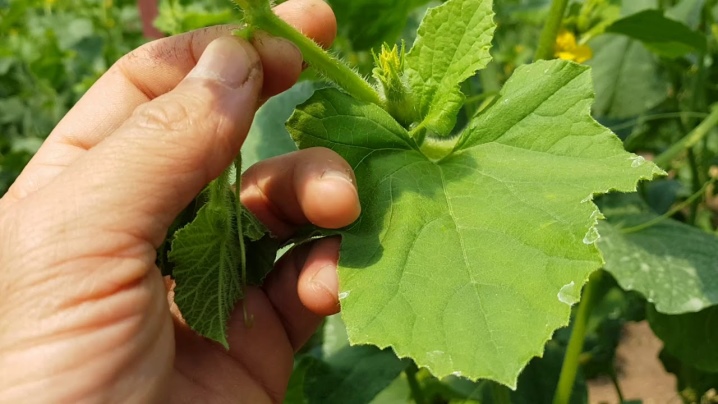
How to Harvest?
Finally, the day has come when the cucumbers that you have been waiting for are still ripe. There are some collection rules. Experts recommend following the tips below.
- The best time to harvest cucumbers is early morning.... But this can also be done in the afternoon, when the heat has subsided significantly.
- In order for the ovary to form more actively, growing cucumbers are recommended to be picked regularly... It is best to do this at least every day, or even twice.
- Cut the cucumbers with scissors or a knife. Do not tug, overtighten or twist the stem, otherwise you will damage the plant.
- Abnormal fetuses (damaged, deformed, diseased) should delete periodically.
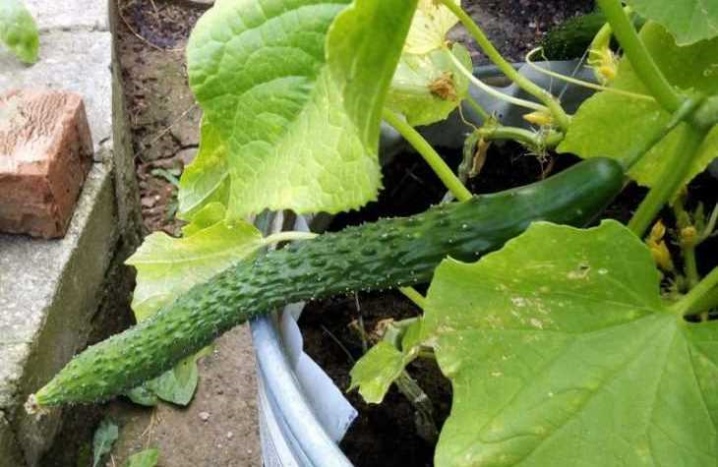
Review overview
The gardeners' comments on the cultivation of cucumbers in barrels are mostly positive. This planting option is especially relevant for owners of small land plots and for beginners. In addition, the crop is easy and simple to care for, which is another reason to forget about outdoor work.
However, it is worth remembering that your plant can be attacked by ants and pests, which should be removed immediately.

The hosts point out that the main thing is to start composting in October so that in the spring you can easily prepare the soil for culture... The first shoots will appear quickly. Gardeners find this method to be the easiest and most productive.
In addition, harvesting cucumbers is a pleasure, and the elderly dacha owners do not have to bend over the garden bed as before.














The comment was sent successfully.